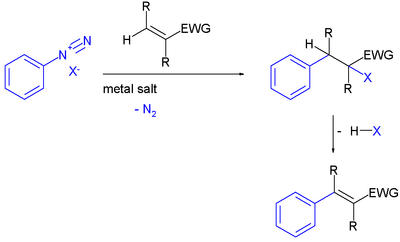- Meerwein arylation
-
The Meerwein arylation is an organic reaction involving the addition of an aryl diazonium salt (ArN2X) to an electron-poor alkene usually supported by a metal salt.[1] The reaction product is an alkylated arene compound. The reaction is named after Hans Meerwein, one of its inventors who first published it in 1939.
An electron-withdrawing group (EWG) on the alkene makes it electron deficient and although the reaction mechanism is unclear [2], involvement of an aryl radical is presumed after loss of nitrogen in the diazonium salt followed by a free radical addition. In the primary reaction product the intermediate alkyl radical is then captured by the diazonium counterion X which is usually a halogen or a tetrafluoroborate. In a subsequent step an elimination reaction liberates HX (for instance hydrochloric acid) and an aryl vinyl compound is formed. The reaction mechanism from the arene's view ranks as a radical-nucleophilic aromatic substitution.
In a general scope a Meerwein arylation is any reaction between an aryl radical and an alkene [3]. The initial intermediate is an aryl enthenyl radical which can react with many trapping reagents such as hydrogen or halogens or with those based on nitrogen or sulfur.
Scope
A reported reaction of alkene acrylic acid with an aryl diazonium salt and copper(I) bromide and hydrobromic acid yields the alpha bromo-carboxylic acid [4]. When the alkene is butadiene the initial reaction product with catalyst copper(II) chloride is a 4-chloro-2-butene and after an elimination the aryl substituted butadiene [5]. In a so-called reductive arylation with 3-buten-2-one, titanium trichloride reduces the newly formed double bond.[6]
In a novel kilogram-scale metal-free Meerwein arylation the diazonium salt is formed from 2-nitroaniline, the alkene isopropenyl acetate is an adduct of propene and acetic acid and the reaction product 2-nitrophenylacetone [7]:
References
- ^ Meerwein, H;, Buchner, E.; van Emsterk, K. J. Prakt. Chem. 1939, 152, 237.
- ^ Strategic Applications of Named Reactions in Organic Synthesis Laszlo Kurti, Barbara Czako Academic Press (March 4, 2005) ISBN 0-12-429785-4
- ^ Minireview Intermolecular Olefin Functionalisation Involving Aryl Radicals Generated from Arenediazonium Salts Markus R. Heinrich doi:10.1002/chem.200801306 Chemistry - A European Journal 2008 Volume 15 Issue 4, Pages 820 - 833
- ^ Benzenepropanoic acid, 4-acetyl-α-bromo- Organic Syntheses, Coll. Vol. 6, p.21 (1988); Vol. 51, p.1 (1971). Link
- ^ 1,3-Butadiene, 1-(p-nitrophenyl)- Organic Syntheses, Coll. Vol. 4, p.727 (1963); Vol. 31, p.80 (1951). Link
- ^ 2-Butanone, 4-(4-chlorophenyl)- Organic Syntheses, Coll. Vol. 7, p.105 (1990); Vol. 62, p.67 (1984) Link.
- ^ A Practical Synthesis of -Aryl Methyl Ketones via a Transition-Metal-Free Meerwein Arylation Carmela Molinaro, Jeffrey Mowat, Francis Gosselin, Paul D. O'Shea, Jean-François Marcoux, Rémy Angelaud, and Ian W. Davies J. Org. Chem.; 2007; 72(5) pp 1856 - 1858; (Note) doi:10.1021/jo062483g
Categories:- Carbon-carbon bond forming reactions
- Substitution reactions
- Name reactions
Wikimedia Foundation. 2010.


